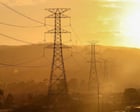Households could be spared unreasonable power bill rises in the future as the Albanese government looks to stamp out price gouging after repeatedprice hikes.
In an address to the AustralianEnergyWeek on Wednesday, Chris Bowen is expected to announce a review of the default market offer (DMO), which sets a benchmark price for residential and small business electricity bills.
The benchmark places a guide on what retailers can charge households and businesses in New South Wales, South Australia, south-east Queensland and Victoria, with consumers encouraged to use it to shop around for better electricity deals.
Bowen will acknowledge the DMO’s role in preventing egregious price gouging and encouraging competitive prices but will concede it has not worked as well as intended.
The DMO is set by the Australian Energy Regulator (AER) in NSW, South Australia and Queensland and by the Essential Services Commission in Victoria.
Sign up for Guardian Australia’s breaking news email
Some NSW customers will face the highest increase in electricity bills from July, expected to be between 8.3% to 9.7%. South-east Queenslanders will be hit with rises between 0.5% and 3.7% and for South Australians rises are expected to be between 2.3% and 3.2%.
Victorians, on the other hand, are expected to see an average 1% bump in bills with some consumers in line for a price drop, according to the Essential Services Commission.
Bowen is expected to point to Victoria’s model as a goal, noting it has significantly smaller bill increases compared to other DMO regions.
“The DMO was intended to act as a benchmark price to stop the worst forms of price gouging, while leaving the job of putting downward pressure on prices to competition between energy companies,” the energy minister will say.
“However, I’ll be frank. I don’t think it’s working that way and reform is needed.”
The potential changes to the AER’s DMO mechanism could include removing the competition allowance as well as putting further restraints on what retailers can claim back from customers in their bills, Bowen will say.
“The vast majority of billpayers, some 80%, could be getting a better deal. It’s difficult to defend the DMO, when the customer is required to do the deal hunting,” he will say.
Sign up toAfternoon Update
Our Australian afternoon update breaks down the key stories of the day, telling you what’s happening and why it matters
after newsletter promotion
“That’s why we have work underway to deliver a better regulated pricing mechanism which will put downward pressure on electricity bills and also ensure the energy market better utilises the huge uptake of rooftop solar and batteries.”
The competition allowance, or the costs to acquire and retain customers (CARC), is factored into the DMO benchmark to acknowledge retailers’ business costs. The AER hasalready excluded the allowancefrom the 2025-26 DMO to provide consumers with a small amount of cost-of-living relief.
Bowen will also use his address todiscuss the $2.3bn planto subsidise small household batteries for solar power.
The energy minister will reveal plans to convene an industry advisory committee in the coming weeks as battery sales outpace new solar systems.
Under the scheme, which comes into effect from 1 July, the cost of household batteries will be slashed by 30% for those with existing solar systems or looking to buy one.
It’s expected to cut the cost of a typical household battery by about $4,000, or 30%, and government analysis shows it could save households up to $2,300 a year, equivalent to 90% of a typical family’s electricity bill.
